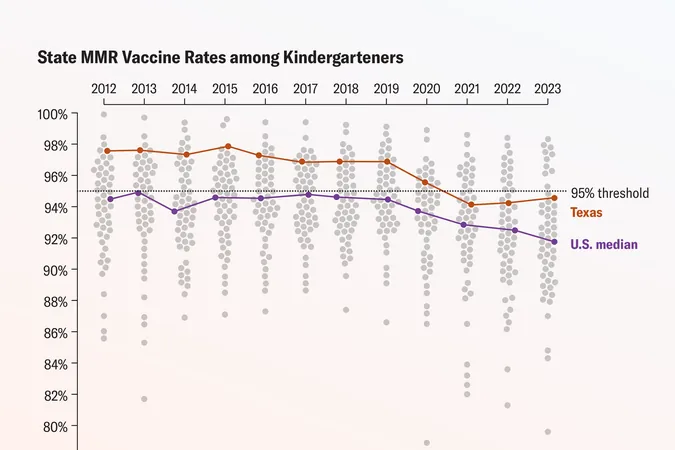
The Dire Consequences of Declining Vaccination Rates: Measles Strikes Back!
2025-03-20
Author: Lok
A worrying resurgence of measles is currently plaguing several U.S. states, raising alarms after sending numerous unvaccinated children to the hospital. Public health officials have confirmed 301 measles cases across the country in just the past two months, with a staggering 170 cases concentrated in Gaines County, West Texas. Tragically, this spate of infections includes the first measles-related death of a child in the U.S. in over two decades. In a separate incident, an unvaccinated adult in New Mexico also succumbed to the virus. The severity of these recent outbreaks has led experts to urgently reassess the nation’s vaccination rates for measles, mumps, and rubella (MMR).
The MMR vaccine, which consists of two doses, boasts a 97 percent efficacy against measles. However, achieving herd immunity requires that at least 95 percent of the population is vaccinated. Currently, Texas's vaccination rate among kindergarteners hovers just below this threshold at 94.3 percent, creating a perfect storm for outbreaks. The spread of the disease has now extended across more than nine counties in Texas, prompting experts to question how even a minor drop in vaccination rates can lead to such significant outbreaks.
Measles: A Local Crisis
The dynamics of local communities play a vital role in outbreak severity. According to Emily Smith, an epidemiologist at George Washington University, real accountability comes from examining community-level vaccination dynamics. For instance, in Gaines County, many initial measles cases originated within a close-knit, under-vaccinated Mennonite population, coupled with a substantial homeschooled demographic that isn’t reflected in the school district data. This suggests that the actual number of unvaccinated children is likely much higher than reported figures indicate.
Texas is among 45 states permitting nonmedical exemptions—including personal and religious ones—from mandatory childhood vaccinations. Last year in Gaines County, nearly one in five kindergarten students opted out of at least one vaccine, a rate five times greater than the national average.
The Deadly Nature of Measles
Measles is more contagious than seasonal influenza, with virus particles lingering in the air long after an infected person departs. One infected individual can potentially spread the virus to as many as 15 people on average. Symptoms typically include a high fever, coughing, and a distinctive red rash. While there is no specific treatment for measles, complications are common; one in five unvaccinated individuals who contract the virus will require hospitalization, often for serious conditions like pneumonia. Grimly, around one in 1,000 children who become infected with measles will die, and similar statistics apply to more severe complications such as encephalitis.
Worse still, a rare yet devastating consequence of measles, known as subacute sclerosing panencephalitis (SSPE), can develop years after recovery, leading to irreversible neurological deterioration and death. Paul Offit, director of the Vaccine Education Center at Children’s Hospital of Philadelphia, speaks to the tragic inevitability of SSPE, stressing that "children who suffer from this will always die."
National Trends: A Grim Toll
In recent years, the rate of childhood vaccinations in the U.S. has begun to stagnate, particularly during the COVID-19 pandemic—when routine immunization appointments were frequently missed. In the 2019-2020 school year, 95 percent of kindergarteners received the necessary vaccines, a figure that plummeted to 93 percent in 2022-2023. MMR vaccination rates have shown a concerning downward trajectory, signaling potential for greater outbreaks in the future.
Public trust in established health measures has also eroded, fueled in part by high-profile figures promoting anti-vaccine rhetoric. The alarming impact of this decline is evident in Texas, where an atypical number of cases has emerged compared to previous outbreaks, sparking fears that measles could once again become a common illness in the U.S.
The importance of herd immunity cannot be overstated. When vaccination rates are high, potential cases—often imported from abroad—do not proliferate. Protecting the most vulnerable members of society, including babies and immunocompromised individuals, relies heavily on high vaccination rates among the general populace.
As we stand on a precarious edge, experts warn that measles is merely the harbinger of worse outbreaks to come. With falling vaccination rates leading to significant public health risks not just for measles, but for other vaccine-preventable diseases, the stakes are higher than ever. Immediate action is needed to revitalize vaccination efforts and curtail the spread of this highly contagious disease before it spirals further out of control.


 Brasil (PT)
Brasil (PT)
 Canada (EN)
Canada (EN)
 Chile (ES)
Chile (ES)
 Česko (CS)
Česko (CS)
 대한민국 (KO)
대한민국 (KO)
 España (ES)
España (ES)
 France (FR)
France (FR)
 Hong Kong (EN)
Hong Kong (EN)
 Italia (IT)
Italia (IT)
 日本 (JA)
日本 (JA)
 Magyarország (HU)
Magyarország (HU)
 Norge (NO)
Norge (NO)
 Polska (PL)
Polska (PL)
 Schweiz (DE)
Schweiz (DE)
 Singapore (EN)
Singapore (EN)
 Sverige (SV)
Sverige (SV)
 Suomi (FI)
Suomi (FI)
 Türkiye (TR)
Türkiye (TR)
 الإمارات العربية المتحدة (AR)
الإمارات العربية المتحدة (AR)